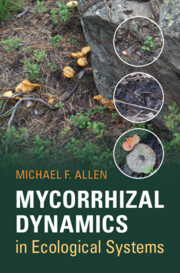Book contents
- Mycorrhizal Dynamics in Ecological Systems
- Mycorrhizal Dynamics in Ecological Systems
- Copyright page
- Contents
- Preface
- Acknowledgments
- Glossary of Key Terms
- 1 Introduction
- 2 Structure–Functioning Relationships
- 3 Evolutionary Ecology
- 4 Physiological Ecology
- 5 Population Ecology
- 6 Community Ecology
- 7 Ecosystem Dynamics
- 8 Mycorrhizae and Succession
- 9 Global Change
- 10 Conservation, Restoration, and Re-wilding
- 11 Conclusion and Summary
- Bibliography
- Index
1 - Introduction
Published online by Cambridge University Press: 25 March 2022
- Mycorrhizal Dynamics in Ecological Systems
- Mycorrhizal Dynamics in Ecological Systems
- Copyright page
- Contents
- Preface
- Acknowledgments
- Glossary of Key Terms
- 1 Introduction
- 2 Structure–Functioning Relationships
- 3 Evolutionary Ecology
- 4 Physiological Ecology
- 5 Population Ecology
- 6 Community Ecology
- 7 Ecosystem Dynamics
- 8 Mycorrhizae and Succession
- 9 Global Change
- 10 Conservation, Restoration, and Re-wilding
- 11 Conclusion and Summary
- Bibliography
- Index
Summary
Travel to your nearest nature reserve. It could be anywhere, within a human habitation or wildland, on continents or islands around the globe. It could be a forest, shrubland, grassland, forbland, or even desert. Across your view is a diverse array of plants, complete with a complex architecture with several levels from the ground surface to the highest leaf, be it a redwood tree extending hundreds of meters into the sky, or a diminutive, but still complex, structure only 10 cm high of mosses, liverworts, and cryptogams. As you separate the stems and look down, you see roots: tens of meters of roots or rhizoids for every square meter of the soil surface. Take your hand lens and pull up some of those roots. There will be soil hanging from those roots, held together by tens to hundreds of meters of threads of fungal hyphae per cubic centimeter. The vast majority of these hyphae form mycelia from many species of fungi, directly connecting fine roots to the larger soil matrix, serving as a living pathway interconnecting the plant, which is actively fixing carbon, within the micro patches of nutrients and water necessary to fix that carbon.
- Type
- Chapter
- Information
- Mycorrhizal Dynamics in Ecological Systems , pp. 1 - 20Publisher: Cambridge University PressPrint publication year: 2022

